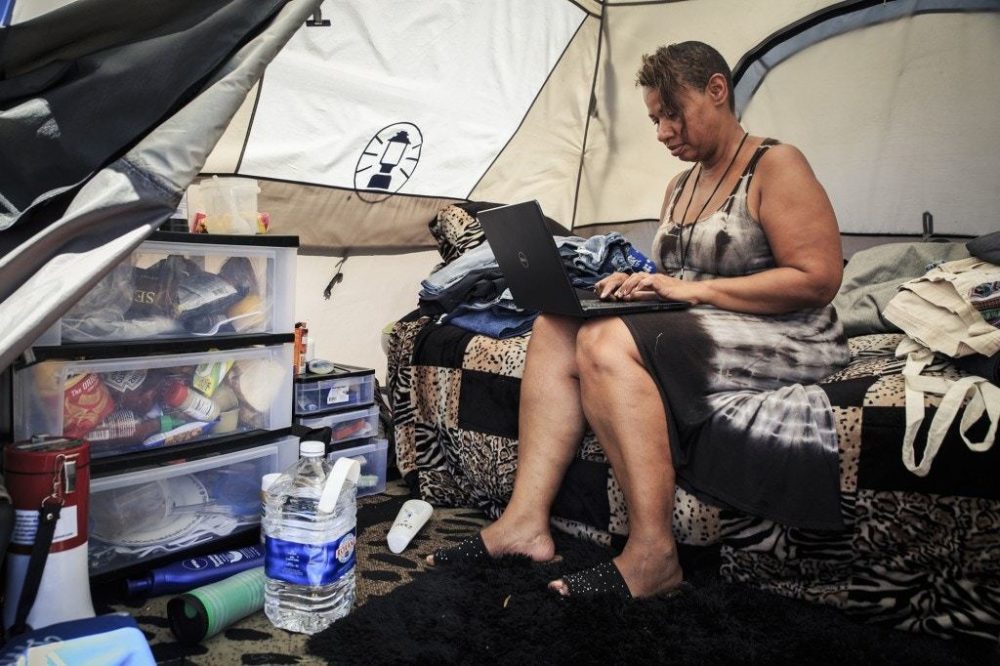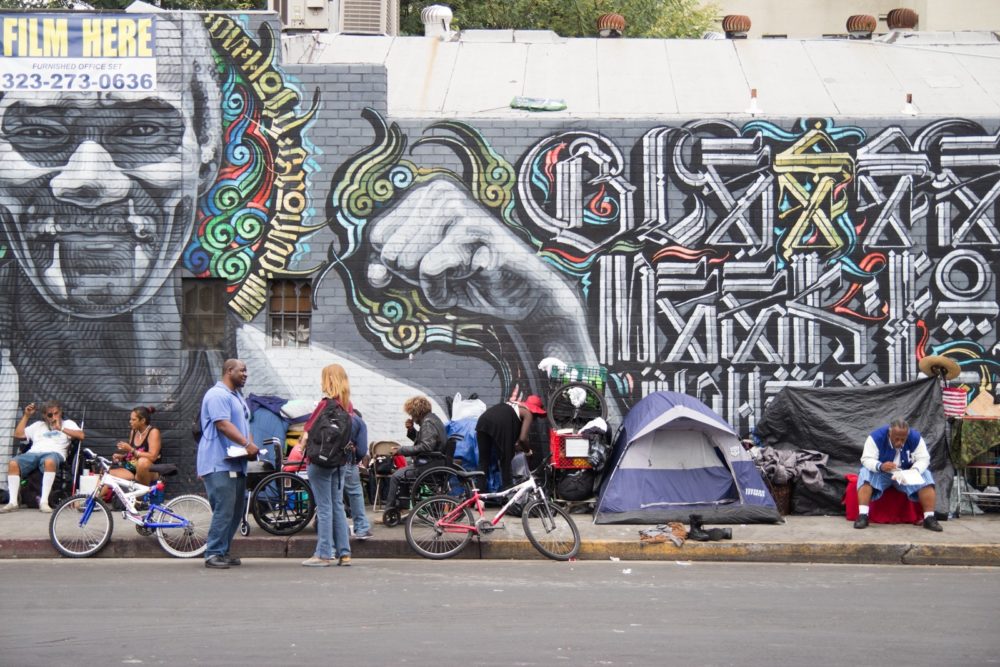Homelessness is one of the most pressing political and humanitarian issues in Los Angeles, with approximately 58,000 people experiencing homelessness throughout the county.LAtimes.com/local/lanow/la-me-homeless-how-we-got-here-20180201-story It is not just that Los Angeles has the largest homeless population in America, it is also the particular concentration of suffering in the downtown Skid Row neighborhood, where between two and five thousand people are living on the streets at any given time. Although the ultimate goal of any homelessness campaign is to rehouse those in need, the crisis is not only a housing question, it is also a question of urban public space and access to information and resources. It is here that we as architects and designers could ask how our current fascination with mobile networked technology, social media platforms, and augmented reality could be put to work for the benefit of the area’s underserved and at-risk communities.
Skid Row is not just a vague zone to describe downtown poverty but an actual place on the map, recognized by both police and residents. Skid Row is delineated by 3rd Street in the northeast, Alameda Street to the east, 7th Street on the southwest, and Main Street on the northwest.Union Rescue Mission, “About Skid Row”, https://urm.org/about/faqs/about-skid-row/, 2018. Starting in the late 1800s, the area that we now call Skid Row was occupied by day laborers looking for work in the rail yards and warehouses. With the slow decline in manufacturing and a long-term disinvestment in downtown in favor of the suburbs, Skid Row has continued to take in more of the city’s poor and underserved minorities. In the early 1970s downtown business developers saw the neighborhood as a lost cause and came together to propose the “Silver Book Plan”Carla Green, “Episode 279, The Containment Plan”, https://99percentinvisible.org/episode/the-containment-plan/, 99 Percent Invisible, 2017., designed to kick out existing residents and bulldoze the neighborhood to start anew. Skid Row residents and advocates fought against the idea and proposed the “Blue Book Plan” instead, which looked to contain the homeless population within Skid Row by moving all missions, charities and social services into the boundaries of the neighborhood we know today. Although it saved the area and its residents, it also continued to attract highly service-dependant individuals to a central congregation point. As the Blue Book Plan, or Containment Plan stated:
“With public restrooms, benches, and pleasant open spaces within the contained area of Skid Row, the residents might be inclined to confine their activities to the immediate area. That section would serve as a magnet to hold undesirable population elements in Skid Row, not against their will but of their own accord. Strong edges will act as buffers between Skid Row and the rest of the central city. When the Skid Row resident enters the buffer, the psychological comfort of the familiar Skid Row environment will be lost; he will feel foreign and will not be inclined to travel far from the area of containment.”
The plan created a buffer zone that symbolically and psychologically quarantined Skid Row residents within the designated boundaries. By focusing on what we might call a kind of “edge condition” in architectural terms, the Blue Book Plan did not alleviate the problem, but rather created a “warehouse zone” where the homeless population was merely hidden out of sight. This urban fragmentation has kept Skid Row segregated from the rest of the city for decades.
Recently, Los Angeles has acknowledged that containment has not worked and the city has increased its efforts to address homelessness in Skid Row.Rath, Arun, and Tom Dreisbach. “As Downtown LA Grows, So Does Urgency To Fix Skid Row.” NPR, NPR, 26 Oct. 2014, www.npr.org/2014/10/26/359112842/as-downtown-l-a-grows-so-does-urgency-to-fix-skid-row. As temporary and long-term housing solutions are in development, we as designers and architects should take advantage of the city’s current political momentum to address the crisis. Beyond the idea of mobile technologies as consumer entertainment platforms, we could also begin to plan and design smart city technologies for Skid Row.
There are a few interesting examples that we can already point out. Soon to be released is a computerized system, operated by the Home for Good program of the local United Way, to link homeless individuals with personalized social services.Beyer, Scott. “Could This Website End Homelessness in Los Angeles?” Government Technology: State & Local Government News Articles, 14 Nov. 2014, www.govtech.com/local/The-Website-That-Could-End-Homelessness-in-Los-Angeles.html. In San Francisco, the Learning Shelter homeless program plans to educate the homeless population in technology skills with a housing component, helping them to reconnect with the working community, with a roof over their heads.Beyer, Scott. “Could This Website End Homelessness in Los Angeles?” Government Technology: State & Local Government News Articles, 14 Nov. 2014, www.govtech.com/local/The-Website-That-Could-End-Homelessness-in-Los-Angeles.html. We could also point to more general approaches that could be adapted for neighborhoods like Skid Row. In recent years digital touch screens have appeared in the subway stations throughout New York City.“MTA Press Releases.” MTA | Press Release | MTA Headquarters | MTA Awards Advertising Contract to OUTFRONT Media for Installation of Digital Screens, 27 Sept. 2017, www.mta.info/press-release/mta-headquarters/mta-awards-advertising-contract-outfront-media-installation-digital. These screens allow commuters to access information such as routes and transfers based on the individual’s destination, with arrival times for incoming trains and delays or changes on specific lines. There are also charging stations that have been placed throughout the city for people who are in need of more juice for their mobile devices. Free wifi is also available in specific locations throughout the city for all to access. If Facebook can launch a drone program to provide worldwide internet accessMetz, Cade. “Facebook's Giant Internet-Beaming Drone Finally Takes Flight.” Wired, Conde Nast, 3 June 2017, www.wired.com/2016/07/facebooks-giant-internet-beaming-drone-finally-takes-flight/. it should be possible to introduce this layer of digital technology into the everyday life of Skid Row.
This “layer” of the digital is also a way that we can think about the effects of technology in spatial terms. The discipline of architecture is increasingly more than building design, it is the augmentation of our natural environment, as we design and construct over the natural landscape. Similarly, physically constructed environments and virtual/augmented environments can both be identified as designed environments. These layers, or spheres help us understand just how integral technology has become to our idea of human experience. Architect and educator Michael Rotondi has theorised that we make use of four skins: our biological skin, our clothes, architecture, and data. Rotondi’s layers update Friedensreich Hundertwasser’s theory of Five Skins (epidermis, clothes, houses, identity, and Earth) for our contemporary moment.Pierre Restany, Illustrated by Friedensreich Hundertwasser, “Hundertwasser: The Painter-king with the 5 Skins; the Power of Art”, Taschen, 1978. Furthermore, both Rotondi and Hundertwasser have echoes of Vladimir Vernadsky’s theory of geosphere, biosphere, and noösphere (inanimate, living, and cognitive spheres of the Earth). As Teilhard de Chardin has argued, Vernadsky’s noösphere should be understood as the “collective consciousness of humanity, the networks of thought and emotion in which all are immersed.”Pierre Teilhard de Chardin, "The Phenomenon of Man", Harper Torchbooks, The Cloister Library, Harper & Row, Publishers, 1961, p.278.
In a sense, this immersion in the noösphere is an intellectual and technological sphere, and thus a kind of virtual simulation, designed and built through the imagination of the human race. Augmented reality applications are starting to make this theoretical sphere into a material, architectural reality. On the one hand, projects such as Keiichi Matsuda’s speculative fiction film Hyper Reality suggests a dystopian vision where augmented reality apps and the gig economy makes life miserable, but we can also start to imagine a world in which augmented reality is more like public infrastructure, allowing people to locate services, find employment, search for health information, and inform them of activity or opportunities in their neighborhood. At the moment, homeless people across the county have limited access to these resources, and rely on public libraries to use the internet, charge their phones, and dodge the rain.Richard Gunderman, David C. Stevens, "How libraries became the front line of America's homelessness crisis." The Washington Post, 2015. But libraries are not designed to handle the responsibility of functioning as daytime shelters. We need to design information services into the very fabric of the neighborhood. When we imagine the residents of Skid Row using the kind of apps and networked technologies that we all now enjoy on our laptops and phones we imagine them as equal citizens with access to the resources we now consider to be essential.

